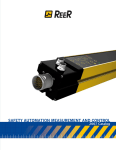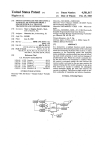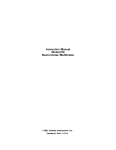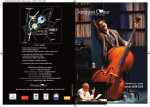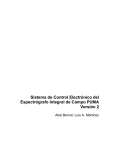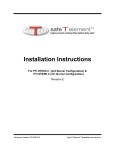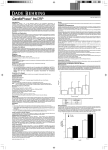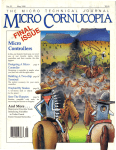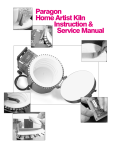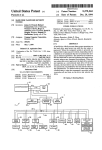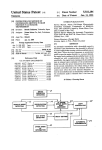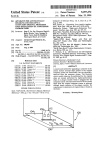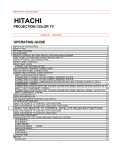Download Method and apparatus for defining magnetic disk track field lengths
Transcript
United States Patent [19] [11] Patent Number: Shenk [45] [54] 4.165531 4,210,959 METHOD AND APPARATUS FOR DEFINING MAGNETIC DISK TRACK FIELD LENGTHS USING A PROGRAMMABLE COUNTER Inventor: William H. Shenk, Acton, Mass. [75] [73] Assignee: 8/1979 7/1980 Apr. 2, 1985 Krause .............................. .. 364/200 Wozniak ........................... .. 364/200 Primary Examiner—Thomas M. Heckler Honeywell Information Systems Inc., [57] ABSTRACT A method and apparatus for de?ning magnetic disk track ?eld lengths using a programmable counter. Use [21] Appi. No: 382,000 May 25, 1982 [22] Filed: ....................................... .. G06F 13/08 [51] US. Int. Cl.~‘ Cl. .............................................. .. 364/200 [52] [53] Field of Search 364/200 MS File, 900 MS File References Cited [56] of a programmable counter in a disk controller permits a reduction in the amount of combinational logic that would otherwise be required to be able to perform the various formatting, reading and writing operations in volved in use of just one type of disk and makes it possi ble to perform these operations on a wide variety of disks having different track and sector formats‘ U.S. PATENT DOCUMENTS 4/1978 Date of Patent: Attorney, Agent, or Firm—Wil1iam A. Linnell; Nicholas Prasinos Waltham, Mass. 4,086,659 4,509,118 Cizmic et al. ..................... .. 364/900 4,148,098 4/1979 McCreight et a1. 364/200 11 Claims, 6 Drawing Figures norm 574 556‘ stcmu WW ADDRESS 578 cum 596 \SELECT y L572 239 ‘ 568 ml , 241 1 nuu PORTED 1 i L m mans: m m SECTOR BYTEGIMK mu? 1 5707 ' m : 249 9502 II scam 0m 243 U.S. Patent Apr. 2, 1985 Sheet 1 of6 m: __ _ 2.5 51 235 0 .5 5.3 28 moi 15:2 “. 82%;. Q63 rm: 81 $5 5,32 $5 4,509,118 U.S. Patent Apr. 2, 1985 Sheet2of6 “E852 35 LIv mo /k 4,509,118 k33 $3.: U.S. Patent Apr. 2, 1985 MEMORY ADDRESS (DEOIMAL) Sheet4of6 4,509,118 MEMORY CONTENTS (HEXIDEOIMAL) SYNO LNUI“"OQDC IDAM —— CYLINDER NO‘ —- HEAD NO. ID FIELD —— SEOTOR NO, -— ORO l ——— CRC 2 GAP 2 _]'— REPEAT FOR: END OF GAPZ, DATA FIELD, GAP 3, GAP 4 F76‘. 4/1 U.S. Patent Apr. 2, 1985 MEMORY ADDRESS IDEDINALI Sheet 5 of6 4,509,118 NENDRY CONTENTS (HEIIIDECINAL) ID AN —-—- CYLINDER N0. —— HEAD N0, ID FIELD ——- SECTOR ND. —-— CRO I _ CRC 2 GAP 2 N 1504M DATA AM 256 BYTES DSER DATA 279 280 28I 282 283 284 DATA FIELD CNC I —-—- CR0 2 BEGINNING OF GAP3 4,509,118 1 METHOD AND APPARATUS FOR DEFINING MAGNETIC DISK TRACK FIELD LENGTHS USING A PROGRAMMABLE COUNTER RELATED APPLICATIONS The following patent applications, which are as signed to the same assignee as the instant application, have related subject matter and are incorporated herein by reference. TITLE Method and Apparatus For vices can be classi?ed as to whether they are hard sec tored or soft sectored. A disk device is referred to as being a hard sectored device if the information is recorded in physically de ?ned blocks of data, referred to as sectors, on the re cording media. For example, in a hard sectored disk, the disk may contain a series of holes which are detected by the disk drive and one sector of information is recorded INVENTORS SERIAL NUMBER William H. Shenk 373,062 William H, Shenk 381,999 Addressing A Peripheral Interface By Mapping Into Memory Address Space Method and Apparatus For 2 Although most disks have used this index mark to indicate the beginning of a track, there is a wide variety of formats used for recording data on disk devices. These various methods of recording data on disk de Generating A Repetitive Serial Pattern Using A Recirculating Shift Register between a starting and ending sector hole. Therefore, in a hard sector disk there is a sector hole which de?nes the beginning of each sector such that a single sector may consist of an identi?cation (ID) ?eld and a data ?eld contained in the sector between two sector holes. In a soft sectored disk format there is usually an ID ?eld delineated by a unique address mark for each sec 20 tor on the disk. The address mark is actually detected by the hardware by violating the coding rules for encoding the information that is written on the disk. For example, if the information is recorded on the disk using a modi BACKGROUND OF THE INVENTION ?ed frequency modulation (MFM) technique, the ad 25 dress mark will be recorded on the disk in violation of 1. Field of the Invention the MFM recording rules such that the violation will be This invention relates to data processing systems; and detected by the hardware. In disks which are soft sec more speci?cally to a method of controlling the trans tored, the identi?cation ?eld which is preceeded by an ferring of data between a peripheral device and a pc address mark is usually followed by a data ?eld which is ripheral controller in a data processing system. also preceeded by an address mark. This results in an 2. Description of the Prior Art address (ID) ?eld and a data ?eld associated with each Current data processing systems have a wide variety soft sector. Using this soft sectored format, it is possible of peripheral devices which are used to input, output to have any number of sectors per track since there is no and store information processed by the system. These hardware mark on the disk to indicate the beginning of peripheral devices include CRT terminals, card readers, a sector. This soft sectored format permits many sectors magnetic tape units and various types of disk devices. having short data ?elds or a few sectors having long Among the disk peripheral devices, there are various data ?elds to be recorded within a given track. Using types including those which have rigid platters, and those which have ?exible platters on which the infor mation is recorded. Among the rigid disk devices there exists several types-those which permit the recording media to be removed from the drive unit and those which have a non-removable recording media. A disk device may contain both a removable and a non-remov able recording media. A recent development in the rigid disk device category includes a non-removable car tridge in which the recording surface is enclosed and some of these devices are known as Winchester type disks. The ?exible disks are also known as ?oppy disks and are usually removable from the disk drive itself. These disk drives are usually interfaced to the data processing system via means of a peripheral controller which contains the logic which controls the reading the soft sectored format, the identi?cation ?eld usually contains information which uniquely identi?es the sec tor by recording a sector number within the ID ?eld. Therefore, using the soft sectored format, the periph eral disk controller must be able to read the ID ?eld and detect when the sector of interest is being read as deter mined by the ID ?eld which is recorded within the 45 sector. This is to be contrasted with the hard sector format in which the number of sector holes past the index mark can be used to determine which sector is currently being accessed. Before a disk can be used to perform normal reads and writes of user data, the disk must usually be initial ized by a formatting operation which lays down on the disk the initial values of the identi?cation ?elds, data ?elds and gaps between ?elds or sectors. This is particu larly the case for soft sectored disks which require that and writing of information from or to the recording media. 55 the identi?cation ?elds and data ?elds be initialized so Information is recorded on a disk in units of data known as sectors. Depending upon the exact format used to record the data, usually more than one sector is recorded in a given track of the disk. The beginning and ending of the track is usually determined by a track index mark which is a notch on the edge of the disk. Therefore, logic is usually provided such that upon the detection of the track index mark, the sector to be read will be located by reading the information on the track that a normal read or write operation can locate the speci?ed sector. One technique for formatting soft sec tored disks is to write the complete track at one time initializing all sectors within that track in one revolution of the disk. This technique can require that suf?cient memory to contain one complete track’s worth of infor mation be available so that the memory can be initial ized with the information required to write one com plete track. Once the memory is initialized, a block until the proper sector is found. Once the proper sector 65 transfer write to the disk is initiated upon the detection is located, the information to be transferred will either of the track index mark. This transfers consecutive be written onto the disk or read from the disk in the words, often containing a repetitive data pattern, from located sector. the memory to the disk until the complete track has 3 4,509,118 been written out from the beginning of the detection of the track index mark until its second occurrence as the disk revolves. Unfortunately, this technique requires a memory sufficiently large to hold multiple sectors of 4 A triple programmable counter is used in a micro processor based disk controller to de?ne the lengths of the various track ?elds. For a soft sectored format, the ID ?eld, data field and overall sector length. including information and results in a memory which is under all gaps, are de?ned. For a hard sectored format, a utilized because, in the performance of normal read or single ID ?eld and data field combination must be de ?ned. All of these ?elds can vary depending upon the particular format used on a disk drive and the type of write operations, a single sector disk read or write can be done using a much smaller memory containing a single sector of information. Another problem which is often encountered in disk controllers is the requirement that a single disk control~ ler handle a wide variety of disk devices. For example, operation being performed. For example, data ?elds may be de?ned to be different lengths depending on the storage capacity requirements of the disk device and depending upon whether a read or write operation is being performed. During a read operation, data ?elds a controller may be required to be able to read or write do not include the gaps whereas during a write opera from a Winchester type disk and also be required to read or write from a ?oppy disk. In addition, there may 5 tion the gaps are included so that they are written onto the disk. be a variety of densities which can be used to record the information on the disk media. For example, it is now BRIEF DESCRIPTION OF THE DRAWINGS common to have both single and double density ?oppy disks within a single system and the format used to record the information on a single density ?oppy disk may vary from that of a double density ?oppy disk and will be different from that of a Winchester type disk. The requirement that a single controller handle this wide variety of disk formats can require that very com plex logic be provided to handle the various counting operations which are required to detect the beginning and end of various ID, data and gap ?elds that are re corded on the disk. Therefore, what is required is a technique which will allow a single disk controller to be used with a wide variety of formats. This same tech nique can be used to perform the various formatting read and write operations found even within a single disk format. OBJECTS OF THE INVENTION Accordingly, it is an object of the present invention to provide a system in which a block of data containing a repeated pattern can be transferred to a peripheral device without requiring the complete block to be pres 40 ent before the transfer is initiated. It is another object of the present invention to pro vide logic that allows different formats of blocks of data to be transferred with a minimal number of combina tional logic elements to control the transfers as a func 45 The manner in which the method of the present in vention is performed and the manner in which the appa ratus of the present invention is constructed and its mode of operation can best be understood in light of the following detailed description together with the accom panying drawings in which like reference numbers iden tify like elements in the several ?gures and in which: FIG. 1 is a block diagram of a clustered display con troller system containing the present invention; FIG. 2 is a logic block diagram of the disk controller of the system shown in FIG. 1; FIG. 3 illustrates the track format of a soft sectored Winchester type disk that is used by the system shown in FIGS. 1 and 2; FIG. 4A illustrates the memory contents during pass 1 of a formatting operation used to initialize the track format shown in FIG. 3; FIG. 4B illustrates the memory contents during passes 2 and 3 of a formatting operation used to com plete the initialization of the track format shown in FIG. 3; and FIG. 5 is a more detailed logic block diagram of a portion of the system shown in FIGS. 1 and 2 and illus trates the present invention. DESCRIPTION OF THE PREFERRED EMBODIMENT tion of the different block formats. It is a further object of the present invention to pro vide logic that allows for flexible block formats to be utilized but yet still allows for the fast transfers of blocks of data. It is a still further object of the present invention to provide a low cost peripheral controller. This invention is pointed out with particularity in the appended claims. An understanding of the above and further objects and advantages of this invention can be The method and apparatus of the present invention is incorporated into the disk controller of the system illus trated in FIG. 1. FIG. 1 illustrates a clustered display obtained by referring to the following description taken in conjunction with the drawings. displays 1 through 16 via display controller 107. Clus tered display controller 107 may be located in relatively SUMMARY OF THE INVENTION A method and apparatus for defining magnetic disk track ?eld lengths using a programmable counter. Use of a programmable counter in a disk controller permits a reduction in the amount of combinational logic that would otherwise be required to perform the various formatting, reading and writing operations involved in use of just one type of disk and makes it possible to perform these operations on a wide variety of disks having different track and sector formats. system capable of controlling up to 16 displays, display 1 111, display 2 113 through display 16 115. Displays 1 through 16 are connected to clustered display control ler 107 such that data entered from a keyboard of the display may be transmitted via clustered display con troller 107 to a host computer 117. Conversely, the data originated in host computer 117 may be displayed on close proximity to host computer 117 or may be re motely located with transmission between the clustered display controller 107 and host computer 117 taking place over telephone lines connecting the two. Disk controller 105 is coupled to clustered display controller 107 to provide local storage of information and programs used by the clustered display controller 107. The transfer of information to and from the disk controller 105 to clustered display controller 107 takes place via peripheral interface logic 109 within clustered display controller 107. In the preferred embodiment, 5 4,509,118 disk controller 105 is capable of having one or two disk devices, disk 1 101 and disk 2 103. In the preferred embodiment, disk 1 101 and disk 2 103 may be con?g ured as follows: a single Winchester type disk drive, one Winchester type disk drive and one ?oppy disk drive, or two ?oppy disk drives. In the preferred embodiment, disk controller 105 is a microprocessor based controller which may be up to ten feet from the clustered display controller 107. Disk controller 105 does all of the data retrieval, read/write 6 disk subsystem, and to reset the disk controller and cause the microprocessor 231 to begin executing the disk controller ?rmware at location 0. Bus 229 represents the data, address and control bus ses which connect microprocessor 231 with other com ponents of disk controller 105. Random access memory (RAM) 235 is a writable memory used as a workspace by the disk controller operating system ?rmware. This 1K by 8 bit memory is used to contain images of the control area found in the dual ported memory located in head positioning, and status updating required by the the peripheral interface logic 109 of the clustered dis disk operating system software which is resident and play controller 107. Disk data timing and control logic executes in the clustered display controller 107. Com 239 provides the timing and control of data going to or munications between the clustered display controller from disks 201 and 203. Dual ported sector RAM 241 is 107 and disk controller 105 is done via by a byte parallel 15 a 1K by 8 bit memory that is used to store sectors of disk interface 119 which is protected by a parity bit. Periph data which are being written onto disk 201 or 203 or eral interface logic 109 in clustered display controller sectors of disk data read from disk 201 or 203. Dual 107 acts as an instruction decoder and a dual ported ported sector RAM 241 is used as an intermediate stor memory. An application program executing in the clus age of the disk data as it is transferred between clustered tered display controller 107 may access a command area or a status in the buffer memory of peripheral interface logic 109 as well as the data area. This dual ported memory is shared between disk controller 105 and the display controller 107 and disks 102 and 103. Parallel/serial bidirectional shift register 243 is used disk controller 105. Disc controller 105 periodically scans the dual ported memory in the peripheral inter face logic 109 for new commands and updates the status 201 and 203 and is stored in dual ported sector RAM 241. Comparator and CRC logic 249 is used to check accordingly. ters as the data is transferred between the disk and the to convert the data from 8 parallel bits to a serial bit stream as the data goes from dual ported sector RAM clustered display controller 107 and is the vehicle by 241 to disks 201 and 203 and to convert it from a serial which all but the most basic commands are passed to 25 bit stream to 8 parallel bits as the data comes from disks and generate cyclic redundancy checks (CRC) charac Disk controller 105 will now be described in more 30 dual ported sector RAM 241 and also allows a compari son between the data stored in dual ported RAM 241 and the data from either disk 201 or 203. Winchester functions to the disk drives attached to disk controller data interface logic 251 is the interface logic which 105. In FIG. 2, disk drive 1 is shown as being an Win contains differential drivers and receivers for data being detail with reference to FIG. 2. Microprocessor 231 controls all head positioning, data transfer and status chester disk 201 and disk drive 2 is shown as being a 35 written onto or being written read from Winchester ?oppy disk 203. Microprocessor 231, in addition to controlling disk 201 and 203, also controls the interface logic 263 which controls the transfer of commands and data between disk controller 105 and clustered display disk 201. Floppy data separation and precompensation logic 253 performs the data separation and precompen sation functions required of data going to or from ?oppy disk 203 in either single or double density mode. controller 107. As discussed hereinbefore, disk 201 is illustrated in In the preferred embodiment, microprocessor 231 is FIG. 2 as being a Winchester type disk and disk 203 is an Intel 8085A microprocessor which is an S‘bit parallel illustrated as being a ?oppy disk. In the preferred em central processing unit and is described in the Intel bodiment as described hereinbefore, disk controller 105 publication entitled, MCS-80/85 Family User's Manual, can be configured to have either a single Winchester copyrighted 1979, which is incorporated herein by ref 45 disk and/or a single ?oppy disk or it can be con?gured erence. Clock 233 is coupled to microprocessor 231 and to have two ?oppy disk drives. If two ?oppy disk drives provides the basic clock frequency utilized by micro are con?gured in the system, disk 201 would be the processor 231. Read only memory (ROM) 237 is an 8K second ?oppy disk and, instead of being connected to (1K equals l024) by weight bit memory which contains Winchester data interface logic 251, it would be con programs (or microprograms) executed by micro 50 nected to ?oppy disk separation and precompensation processor 231. 2K of ROM 237 is used for diagnostic logic 253. programs and the remaining 6K of ROM 237 is used for Drive status ports 247 provide status information the disk controller operating system firmware. from disk drives 201 and 203 which consists of drive Con?guration switches 255 are manually set when ready, track 0 detection, and write protection indica the disk subsystem is con?gured to indicate the types of 55 tors. Drive control ports 245 contain the logic associ disk drives (Winchester or ?oppy disk) actually at ated with stepping the disk read/write heads, the write tached to the disk controller 105. Diagnostic light emit gate, the read gate, and the in case of the Winchester ting diodes (LEDs) 257 are 8 diagnostic indicators that disk which can have up to 4 read/ write heads, the selec are used to indicate the status of the disk subsystem as tion of the read/ write head. determined by the execution of the diagnostic programs The operation of the logic illustrated in FIG. 5 will stored in ROM 237. Panel LEDs 261 are indicating now be discussed in conjunction with the formatting of lights located on the front panel which are used to indi a Winchester type disk. The format of the data on Win cate whether the disk subsystem is in a bootstrap mode, chester disk 201 is illustrated in FIG. 3. The Winchester which of the two possible disk drives is selected and drive 201 consists of either one or two non-removable error conditions. Panel switches 259 are operator select 65 platters. Each platter provides two usable surfaces, each able switches which are used to write protect informa with its own read/write head. A single platter unit tion stored on the disks, to indicate which of the two contains two heads (1 for the top surface and l for the possible disk drives are to be used for bootstrapping the bottom surface), a two platter unit contains four heads. 7 4,509,118 The platters are composed of 256 cylinders. A cylinder is the path over which the heads pass during one revolu‘ tion of the platters. One cylinder contains all the data that can be accessed without moving the read/write lead radially on the platters. The cylinder closest to the outside edge of the platter is cylinder 00. The innermost cylinder is 255. A track contains all the data accessed by a single head in a single cylinder. 8 normal read or write operation from or to the disk, the disk must be completely initialized. Initialization con sists of writing on the disk, the track format illustrated in Hg. 3 so that each sector of each track of each cylin der is written onto the disk. During this formatting operation, it is necessary that during one pass of the track under the write head to write all of the ID ?elds and gaps associated with that track onto the disk. As mentioned before, this could be done by having a Each track is divided into 32 sectors which are num bered sequentially 0 to 31. The format is a soft sectored 0 memory with suf?cient capacity to hold all of the bytes associated with one track and initializing the memory to format (i.e., sectors are delineated by information re contain the image of the track format. Then, on the corded on the track and not by physical sector index detection of the track's index mark, the ?rst word could marks). Each sector is divided into an (ID) ?eld fol be read from the memory and written onto the disk and lowed by a data ?eld. Each of these ?elds is preceeded by a unique address mark (AM). The encoding method 5 consecutive words read and written until the index used is modi?ed frequency modulation. FIG. 3 shows the track/sector format. A description mark is again detected. However, this approach would of each of the ?elds follows: The SYNC ?eld is a stable ferred embodiment, a memory containing 10,416 bytes of data. In the preferred embodiment this required ca data pattern of all Us to allow the phased locked loop require, in the case of a Winchester disk, in the pre data separator to acquire lock on the read data. An 20 pacity of 10,416 bytes greatly exceeds the 1,024 bytes of memory available in dual ported sector RAM 241. address mark preceeds both the ID and data ?elds. It is 2 bytes in length with the ?rst byte always an A1 (hex idecimal, base 16 notation indicated in FIGS. 3, 4A and Therefore, in the preferred embodiment instead of writ ing the total track format in one single pass, all of the ID 4B by signal quotes around the numbers) followed ei ?elds are written in a ?rst pass and the even sector data number ?elds are written during a second pass and the odd numbered sector data ?elds are written in a third ther by an FE(16) which de?nes an ID address mark. The A1(l6), i.e., base 16, pattern is made unique to any other serial bit combination, violating the encoding rules of MFM by omitting one clock bit. CYL is a single pass. By splitting the format operation into three passes, the l,024 bytes of information available in the dual byte which indicates the cylinder address. 00(16) indi cates the outermost cylinder and FF(l6) the innermost cylinder for a total of 256 cylinders. HD is a single byte ported sector RAM 241 is more than sufficient to for which indicates the head address. A one platter disk has 2 heads, and a 2 platter disk has four heads. The head address range is 00(16) to 03(16) for a total of 4 heads. initializing individual tracks using less memory than contained in one track and is made possible by the logic illustrated in FIG. 5. mat the disk and to do normal read and write operations from and to the disk. This ability to format a disk by SEC is a single byte indicating the sector address. The In the preferred embodiment, incrementing address number of sectors per track is 32. The sector address range is 00(16) to 1F(l6). CRC 1 and CRC 2 are two register 566 is comprised of 3 cascaded Texas Instru ments type SN74LS193 synchronous 4-bit up/down counters to form a 10-bit address register and shift/stor bytes of cyclic redundancy check bits generated by the age register 504 is a Texas Instruments type SN74LSl99 controller in order to detect errors. The polynomial used is X(16)+X(l5)+X(2)+ 1 on both the ID ?eld and 40 8-bit universal shift/storage register. Both of these com ponents are described in the Texas Instruments publica the data ?eld. The data field is 256 bytes of user pro tion entitled, The TTL Data Book For Design Engineers, vided data. Gap 1 immediately follows the track index mark. This ?eld consists of 15 bytes of 4E(l6). The trace index Second Edition, copyrighted 1976, which is incorpo rated herein by reference. In the preferred embodiment, mark is generated by photo electrically detecting a 45 CRC generator 528 is a Fairchild type 9411 CRC generator/checker described in their data sheet entitled, notch in the edge of the platter. This track index signal 9411 CRC Generator/Checker, copyrighted 1978, which as illustrated in FIG. 3 is supplied by the disk drive once is incorporated herein by reference. each revolution to indicate the beginning of all tracks The logic illustrated in FIG. 5 permits the dual on a disk drive. Gap 2 separates the ID ?eld from the data ?eld. It provides a known area for the data ?eld write update splice to occur. The remainder of this ?eld ported sector RAM 241 to be initialized to the contents shown in FIG. 4A for writing the ID ?elds during the also serves as the synchronization area for the data ?eld ?rst pass and to the contents shown in FIG. 4B to write address mark. This gap contains 15 bytes of 00(16). Gap the second portion of gap 2, the data ?eld, and the ?rst portion of gap 3 as shown by the amount of data written during a write update in FIG. 3. 3 is a speed variation tolerance area for the sector. It consists of 15 bytes of 4E(16). Gap 4 is the speed toler ance area for the entire track. It consists nominally of FIG. 4A will now be discussed in detail. FIG. 4A illustrates the contents of dual ported sector RAM 241 as set up for the ?rst pass of a formatting operation The total nominal track capacity is l04l6 bytes. The being performed on a Winchester disk 201. Prior to the minimum track is the nominal track capacity adjusted for a minimum 3 percent speed variance and is therefore 60 initiation of the ?rst pass of the formatting operation, microprocessor 231 initializes dual ported sector RAM 10102 bytes. The write update signal illustrated in FIG. 353 bytes of 4E(l6). 3 shows the among of data within a sector that is up dated each time a sector of data is written on the disk. During normal read or write operations from or to 241 to contain the information shown in FIG. 4A in memory location 0 through 39. After the microproces sor has set up dual ported sector RAM 241 to contain the disk, data is read from the disk or written to the disk 65 the data shown in FIG. 4A, the microprocessor initial izes a series of counters in disk/data timing control logic one sector at a time. For the Winchester disk, this al 239 and initializes incementing address register 566 to lows the user to read or write 256 bytes of information address location 0 of dual ported sector RAM 241. at one time. However, before a user can perform a 9 4,509,118 Once these preliminary steps are completed, micro processor 231 is placed in the hold mode thereby pre venting it from doing further operations on dual ported sector RAM 241 and also tri-stating the bus 229. The actual data transferred to the disk then begins under the control of disk/data timing and control logic 239 in 10 the binary ONE state. This same signal is connected to the select (SEL) input and used to select between the A and B inputs of multiplexer 542 so that as long as the CRC is being generated, the data on line 506 is multi plexed onto line 544 as data to the disk and after the CRC is computed, the data from the output of CRC conjunction with parallel/serial bidirectional shift regis generator 528 on line 540 will be multiplexed onto line 544 as the data to the disk. ter 243 and compare and CRC logic 249 which is shown in greater detail in FIG. 5. Having initiated the computation of the cyclical re Once the microprocessor is put in the hold state and 10 dundancy check for characters, bytes 29 through 33 are the writing of the ?rst pass of the format initiated, the disk controller waits until Winchester data interface logic 251 signals the detection of the track index mark transferred to the disk a bit at a time as described above. When byte 34 is to be transferred, which is initialized to a 00(16) byte in dual ported sector RAM 241, instead of taking the data from line 506 which appears at the A on the disk. Once the track index mark is detected, the 8-bit byte of the ?rst location from dual ported sector RAM 241 as addressed by incrementing address register input of multiplexer 242, signal CRCCNTRL on line 532 which appears at the select (SEL) input of multi plexer 241 selects that the B input data appear at the Y outputs thereof such that the bits of data generated by the CRC generator 258 which appear at the Q output thereof will be transferred to the Winchester disk. After 566 is transferred via line 502 to be loaded into shift/s torage register 504 by the load/shift signal on line 510 at the function select (S0) input being in the load state and the S1 input on line 514 being in the binary ONE state. Once loaded with the ?rst byte of data, shift/storage the ?rst byte of the two byte cyclical redundancy check register 504 is clocked by bit clock signal on line 512 at the clock (CLK) input and the serial data stream ap has been transferred to the disk, the second byte is out put by CRC generator 528 and is written onto the disk pears on line 506 one bit at a time at the QAO output. in place of word 35 which is a 00(16) byte as initialized The serial bit stream on line 506 is fed to the data (D) 25 in dual ported sector RAM 241. input of cyclical redundancy check generator 528 and Having written CRC 1 and CRC 2 for the ID ?eld, to the A input of 2 to l multiplexer 542. The clear the process then continues to write out three bytes of (CLR) input of shift/storage register 504 is not used and 00(l6)’s from locations 36 through 38 which are the ?rst is therefore connected to a binary ONE on line 516. The three bytes of gap 2. When word 39, which contains a output control inputs G1 and G2 are respectively con 4E(l6) data byte is loaded into shift/storage register nected to signals HLDAFFQ and SZODSB on lines 504, a counter in disk/data timing and control logic 239 518 and 520 and are used to disable the eight input/out expires indicating that the last byte of data loaded into put terminals QA to QH by placing them in the high shift/storage register 504 is to be recirculated and be impedance when data is not being transferred between continually written onto the disk until the expiration of shift/storage register 504 and dual ported sector RAM 35 another counter. This byte of 4E(l6) is chosen for the 241. gaps because it is a good pattern on which to lock the At this point in time, multiplexer 542 is selected such phased locked loop data separator used in Winchester data interface logic 251. The recirculation of the last that the data at the A input appears at the Y output thereof and therefore the serial data stream appears on line 544 as data to the disk which is then processed by byte of data from dual ported sector 241 is accom plished by recirculating signal RECIR on line 508 se lecting the A input of 2 to 1 multiplexer 254 such that Winchester data interface logic 251 which performs the modi?ed frequency modulation function before it is the data appearing on the A input will appear on the Y output on line 522 and be entered into the serial input written onto Winchester disk 201. As each bit of the data is written onto the disk, the bit clock signal on line 512 clocks shift/storage register 504 and performs the parallel to serial conversion by shifting one bit of data out. After eight bits have been shifted out of shift/stor age register 504, the byte clock signal on line 570 at the count-up (CNTUP) input of incrementing address reg 45 (SL) of shift/storage register 504. This recirculation has been occurring for all previous words of data loaded into shift/storage register 504 but was overridden by the loading of a fresh byte of data from dual ported sector RAM 241 by the load/shift signal on line 510 every eight bit clocks. Therefore, when the ?rst counter ister 566 and increments to the next memory location so 50 expires upon the loading of the byte 39 into shift/stor that the next memory location from dual ported RAM 241 will be available for loading into shift/storage regis age register 504, the periodic loading is inhibited and the recirculating mode of operation is entered. ter 504 under the control of load/shift signal on line 510. This process continues until location 29 starts to be hold state and is free to update the contents of dual At this time, microprocessor 231 is removed form the transferred bit by bit to the disk. Location 29, which 55 ported sector RAM 241. Microprocessor 231 goes back contains Al(l6), is the ?rst byte of the ID ?eld and and increments byte 33 to the next sector number of the requires that CRC generator 528 is reset by signal CRC sector which will be formatted on the disk. Once this RESET on line 598 at the master reset (MR) input so incrementing of the sector number in location 33 has that the cyclical redundancy check may be computed been accomplished, the microprocessor is again placed on the ID ?eld. The binary ZERO signals on lines 534 in the hold state while the 4E(l6) byte of data from and 538 at the S0 and S2 polynominal select inputs location 39 is written on to the disk for the completion along with signal 0P08 on line 536 at the S1 polynomi of gap 2, all of the data ?eld and the ?rst three bytes of nal input selects which polynominal is used to compute gap 3. After the ?rst three bytes of gap 3 have been the cyclic redundancy check characters. The CRC written onto the disk another counter expires indicating generator 528 is clocked by signal bit clocking signal PLOLR on line 530 at the clock (CLK) input. Compu tation of the CRC is enabled by signal CRC CNTRL on line 532 at the check word enable (EWE) input being in 65 that all but the end of gap 3 of one sector of data has been written to the disk. At this point, incrementing address register 566 is reset by the reset signal on line 568 at the clear (CLR) 11 4,509,118 12 example, during pass 2 the data ?elds of all of the even numbered sectors are written and during pass 3 the data fields of all of the odd numbered sectors are written. During passes 2 and 3, in addition to writing the data ?elds, the end of gap 2's and the beginning of gap 3’s are input and the process is started over with location 0 of dual ported sector RAM 241 being loaded into shift/s torage register 504. The second sector of data is then formatted onto the Winchester disk 201. This process is repeated until 32 sectors of data have been written in written as can be seen by the amount of data that is the track being formatted on the disk. During the sec written during a write update as illustrated in FIG. 3. ond and subsequent sectors within the track, bytes 0 Prior to the beginning pass 2 of the format operation, through 14 are used to complete the writing of gap 3 microprocessor 231 initializes dual ported sector RAM instead of the writing of gap 1 which appear only at the beginning of a track. After 32 sectors have been written 0 241 to contain the data pattern illustrated in FIG. 4B. The data in dual ported sector 241 is used in two ways on the track, a further counter expires and instead of in passes 2 and 3. Bytes 0 through 9 are used to locate inhibiting the circulation of the last byte of data and the sector to be written and bytes 10 through 284 are resetting incrementing address register to location 0 the used to write the sector onto the disk. Locations 0 recirculation is allowed to continue such that 4E(16) bytes will be written until the track index mark is en . .a 5 through 6 contain the ID ?eld of the sector which is to be written and are initialized to contain the ID address countered. The track index mark terminates the writing mark, the cylinder number of the cylinder which is to be of the track with the writing of gap 4 and takes micro written, the head number of the head which is to be processor 231 out of the hold mode. used to write on one surface of the cylinder and the Placing microprocessor 231 in the hold mode places sector number of the sector within the track which is to bus outputs of the microprocessor in the high impe be written. Locations 5 and 6 are initialized to contain dance state so that bus 229 can be used b other logic in 00(l6)’s for the cyclical redundancy check character but these bytes are effectively ignored and the cyclical redundancy check character generated by CRC genera ory 241 is being accessed by parallel/ serial bidirectional shift register 243 also guarantees that there will never 25 tor 528 is compared with the cyclical redundance check disk controller 105 without interference. Placing micro processor 231 in the hold mode when duel ported mem character read from the disk. Locations 7 through 9 contain the 00(16) bytes which are the ?rst part of gap 2. Locations 10 through 21 contain twelve 00(16) bytes arise a condition in which access by register 243 to memory 241 will be inhibited because of a memory access being made by microprocessor 231. This simpli ?es the logic and reduces the need for any buffering between memory 241 and register 243 that would other wise be required due to the fast disk transfer data rates. A comparison of FIG. 4A with the track format shown in FIG. 3 will show that upon the completion of the ?rst pass of the formatting operation, the gap 1 has been written with the ?nal data, the sync ?eld has been written with the ?nal data, the ID ?eld has been written which are to be written onto the disk to complete the end of gap 2. Locations 22 and 23 contain the data address mark. Locations 24 through 279 contain 256 bytes of 00(16) data which are to be written as the user data within the data ?eld so that the user data will be initially set to all zeros. Locations 280 and 281 are ini tialized to 00(l6)’s but will be replaced in the data stream to the disk with the cyclical redundancy check character generated by CRC generator 528 which will with the ?nal data including the proper generation of the CRC 1 and CRC 2 cyclical redundancy checks, the be the actual information written onto the disk. Loca tions 282 through 284 contain three bytes of 00(16) data ?rst three bytes of gap 2 have been written with the ?nal data. The remainder of gap 2, the complete data 40 which are written onto the disk to initialize the begin ning of gap 3 to its ?nal value. ?eld including CRC 1 and CRC 2 and the ?rst three During passes 2 and 3 of a disk formatting operation, bytes of gap 3 have been written with the value of which is similar to a disk normal write operation and 415(16). The remainder of gap 3 has been written with normal read operation, the disk/data timing and control its final data and gap 4 has been written with its ?nal logic 239 controls the locating of the sector to be writ data. Therefore, what remains to be written with the ten or read. This sector locating operation takes place ?nal data is the end of gap 2, the data ?eld and the after the microprocessor 231 has initialized dual ported beginning of gap 3. All of this data is updated during a sector RAM 241 to contain the ID ?eld of the sector to write update operation which will be done during sec be located and the user data to be written on memory if ond and third pass of the format operation. a write is involved. Once microprocessor 231 is placed In reviewing FIG. 4A, it can be seen that locations in the hold mode, the sector locating operation begins. 3i, 32 and 33 must be initialized by the microprocessor During the sector locate phase of passes 2 and 3, the 231 to contain variable data. Location 31 contains the read head within Winchester disk 201 associated with cylinder number of the track that is being written and it the track on which the sector that is to be located re is a value of 00(16) to FF(16) (i.e., 0 to the 255 decimal). sides, is turned to the read mode. As data is read from Location 32 contains the head number of the surface the disk, Winchester data interface logic 251 detects the being written and will contain a value for 00(16) to occurrence of both gap 1 or the end of gap 3 both of 03(16). Location 33 will contain the sector number of the sector that is being written and will contain a value which consists of 15 bytes of 4E(l6) data. This 4E(16) bit pattern is chosen because it is a good pattern for the of 00(16) to 1F(l6) (i.e., O to 31 decimal). During the formatting of any given track which takes place in the phased locked loop circuitry within the Winchester three passes, only location 33 which contains the sector number needs to be updated as each sector is written during the writing of any one track because the cylinder data interface logic 251 to become locked onto. This same 4E(l6) bit pattern was used to temporarily initial ize the data ?eld of the sectors during pass 1 for this and head numbers of all sectors within one track are the same. After pass 1 of the disk formatting operation is com pleted, passes 2 and 3 are written.‘During pass 2 and 3, the data ?eld of half of the sectors are written. For same reason. 65 Once the phased locked loop circuitry becomes locked onto the data being read from the disk, the Win chester data interface logic 251 begins to look for the occurrence of the “Al" address mark. When this oc 13 4,509,118 curs, the Winchester data interface logic 251 signals compare and CRC logic 249 that a comparison should begin between the ID ?eld being read from the disk which appears on line 526 and the data coming from dual ported sector RAM 241 which will appear on line 544. Therefore, once the end of the sync field is de tected, incrementing address register 566 is reset so that it addresses location 0 of dual ported sector RAM 241 which loads the shift/storage register 504 via line 50 with the ?rst byte of data of the ID ?eld. As each bit clock occurs, the data is shifted out on line 506 which is selected as the input of multiplexer 542 and therefore appears on line 544 as data to the disk. However, in this case of sector locating, the data is not actually trans 14 the disk, after receiving the three 00(16) bytes which comprise the beginning of gap 2 and match the data stored in locations 7 through l0 of dual ported sector RAM 241, the disk/data timing and control logic 239 can safely assume that the current sector being read from Winchester disk 201 is the same as the sector ad dressed by the ID ?eld stored in dual ported sector RAM 241. At this point in time, disk/data timing and control logic 239 changes the mode of operation from a read mode which occurs during the sector locate phase of passes 2 and 3 to a write mode of operation and the data in locations 10 through 284 is written onto the disk in a manner similar to that used to write the data during pass ferred to the disk because a read operation is in 1 of the format operation. During this portion of pass 2 progress. and pass 3, the second part of gap 2 is initialized to its During this sector locate phase of a pass, the data ?nal 00(16) value, by writing the words in locations 10 from the disk appearing on line 526 at one input of through 2l onto the disk, the data address mark con exclusive OR 564 can be compared with the data which tained in locations 22 and 23 is written on the disk, and is coming from memory 241 and appearing on line 544 20 a user data ?eld of 256 bytes in initialized to an all zero at the other input of exclusive OR 564. As long as there value. After writing location 279 onto the disk, the is a bit for bit match of the data to the disk with the data output of CRC 528 is multiplexed onto line 544 and the from the disk, the output of exclusive OR 564 on line two byte (16 bit) cyclical redundancy check is written 562, signal DCMPRG, will be a binary ZERO and the onto the disk. Following the writing of the cyclical output of AND gate 558 on line 554, signal 25 redundancy check, the three bytes of 00(16) are written CMPENBG, will be a binary ZERO. onto the disk from locations 282 through 284 thus com The output of AND gate 558 is enabled by compare pleting the initialization of the beginning of gap 3 to its begin signal COMPBEBQ on line 560 being a binary ?nal value. ONE during the time that a comparison is to be made At this point in time, the one completed sector has between the data from the disk with the data to the disk. been initialized and the microprocessor 231 is removed As each bit of data is read from the disk, bit clock form its hold mode and allowed to update location 4 to (CLK) signal on line 556 at the clock (CLK) input of indicate the next sector to be initialized. Because of the compare flip-?op 546 clocks the output of the compara relative speeds between the rate at which the data is tor which appears at the data (D) input thereof thus transferred to or from the disk and the speed of the assuring that ?ip-?op 546 will remain in the reset state microprocessor in its ability to update location 4 in dual so that the compare error signal COMPERR on line 548 ported sector RAM 241, every other sector is written at the Q output will remain a binary ZERO as long as during pass 2 and pass 3 such that when microprocessor there is a bit by bit match of the data coming from dual 231 updates the location 4 it increments it by 2 so that ported sector RAM 241 with the data coming from during pass 2 all of the even numbered sectors are writ Winchester disk 201. ten and during pass 3 all of the odd numbered sectors Once there is a mismatch, compare ?ip-?op 546 will are written. become set and the Q-bar output signal DFENL on line Once having updated location 4 in dual ported sector 550, which is connected back to the preset (PR) input, RAM 241, the microprocessor is again put in the hold will assure that the compare ?ip-flop remains set until mode and a sector locate operation is initialized. When cleared by a signal AMFH appearing at the clear (CLR) 45 the next sector to be written is located, the writing of input on line 552. It being noted that before the sector the data field takes place as described above. Once all 16 locate operation was begun, compare ?ip-?op 546 was of the even numbered sectors are written during pass 2 cleared by signal AMFH on line 552. The occurrence of the 16 odd numbered sectors are written during pass 3. the compare error signal on line 548 is used to reset the Once the disk is completed formatted by performing all Winchester data interface logic 551 to again look for a three passes on each track within the disk, the disk is gap 1 or a gap 3 data pattern followed by a sync pattern then available to perform normal read and write opera and then followed by and ID ?eld from the disk which tions. A normal write operation is very similar to that matches the ID ?eld from dual ported sector RAM 241. described above for pass 2 and pass 3 of the format This mismatch of data will occur during a pass 2 or pass operation with the exception that locations 24 through 3 of the formatting operation if the sector number of the 55 279 will contain the actual user data which is to be sector currently being read from the disk is not the same written within a sector as shown in FIG. 4B. as the sector number contained in location 4 of the dual As described above, each sector locate operation is ported sector RAM 241. performed during pass 2 or pass 3 of a format operation If location 0 through 4 in dual ported sector RAM or during the single pass of a normal read or write oper 241 match the data coming from the disk, which ap ation. Each time a mismatch is found between the ID pears on line 526, the output of CRC generator 528 is ?eld located in dual ported sector RAM 241 and the multiplexed onto line 544 by the CRC control signal on data coming from Winchester disk 201, the increment line 532 selecting the B input to be output to the Y ing address register 566 is reset to address memory output of multiplexer 542. It being noted that CRC location 0 by the reset signal on line 568 which appears generator 528 was generating the CRC based upon the 65 at its clear input. During a normal sector read or a data received at the data input from lines 506 for bytes normal sector write operation, the logic in FIG. 5 oper 0 through 4. If the CRC characters generated by CRC ates in a manner same as that described above for passes generator 528 match the CRC found in the data from 2 and 3 of the disk formatting operation. 15 4,509,118 During a normal sector write operation, the write head is activated and locations 10 through 284 contain ing the end of gap 2, the actual user data and the begin ning of gap 3 are written onto the disk along with the 16 TABLE l-continued Floppy Disk Single Density Format Frequency Modulation (FM) Encoding FF(l6) Address mark (1 byte). cyclical redundancy check characters generated by TRK CRC generator 528 which are also written onto the Track number byte between 00(16) to 4C(l6) for single sided media and 00(16) to 99(l6) for double disk. Thus, during a normal sector write operation, dual ported sector RAM 241 need contain only the contents being initialized in locations 0 through 284 (see FIG. 48). During a normal sector read operation which is SEC similar to the normal write operation, for locations 0 to 9 at which point the logic looks for the data address Data sided media (1 byte). Sector number byte between 00(16) to lF(l6) (1 byte) mark. Upon detection of the data address mark, the data input multiplexer 524 is selected to multiplex the B input onto the Y output such that the data coming from the 15 disk on line 526 will enter the serial input (SL) of shift/storage register 504 and once the full eight bits of 128 bytes of user data (128 bytes). Cyclic redundancy check CRC l CRC 2 bits created by controller using a polynominal X(l6) +X(l5) +X(l4) +X +1 on address mark, track, sector, and data bytes (2 one byte have been assembled in it, the data is trans ferred over line 502 to be written into dual ported sector RAM 241. Thus, the data from the disk will be written bytes), Gap 2 of 00(l6) generated by controller. The gap length is determined by drive and media into locations 10 through 265 of dual ported sector RAM 241 with the 12 bytes of 00(16) at the end of gap 2 not being written (see FIG. 4B). During a normal sector read operation, after all 256 bytes of the user data have been read into dual ported sector RAM 241, the TABLE 2 error (ER) output of the CRC generator 528 on line 541 Floppy Disk Double Density Format tolerances. will be checked to see if a CRC error occurred. Modi?ed Frequency Modulation (MF M) Encoding From the above discussion, it can be appreciated that the present invention in which a parallel to binary shift register is used in a recirculating mode allows access to 32XFF(16) the dual ported sector RAM 241 during portions of the passes l, 2 and 3 of the format operation under condi separator (32 byte). D006) Address mark (1 byte). TRK Track number byte between 00(16) and 4C(l6) for single tions that would normally not be available to micro sided media and 0006) to 99(16) for double sided processor 231 if the recirculating mode of operation was not employed. Thus, by recirculating the pattern within shift/storage register 504, the microprocessor 231 can access dual ported sector RAM 241 and update the sector number so that sequential sectors may be written with correct sector numbers in one continuous write operation. This freeing up of memory 241 for updating by microprocessor 231 allows dual ported sector RAM 241 to be considerably smaller than would otherwise be required if it was necessary to contain a Gap 1 sync bytes for phased locked loop data media (1 byte). SEC Sector number byte between 00(16) and 1F(l6) (1 byte). Data CRC l CRC 2 256 bytes of user data (256 bytes). Cyclic redundancy check bits created by controller using polynominal X(l6) +X(l$) +X(2) +l 0n address mark, track, sector and data bytes (2 bytes). Gap 2 of FF(16) generated by controllerv complete track’s worth of information in order to write 45 pass 1 of a format operation. The gap length is determined The above discussion has been in terms of the formats by drive and media used on the Winchester disk 201. In addition to the tolerances. Winchester disk 201, the disk controller 105 is capable of having a ?oppy disk 203 attached to it. Floppy disk By examining Tables 1 and 2 and comparing their 203 may be either a single density or double density format with the format for the Winchester disk shown ?oppy disk. Whereas the Winchester disk described in FIG. 3, it can be appreciated that for a single control above has a soft sectored format (i.e., the beginning of ler to be able to write all three formats a large amount the sectors are not de?ned by holes in the platter), the of logic would be required to enable the various count floppy disk has a hard sectored format. The format used ing operations required to write and read these differing on the single density diskette, which is recorded using a formats. In addition, even to write a single format frequency modulation (FM) encoding technique, is would require a wide variety of counters just to per different from that found on the double density diskette form the various formatting, reading and writing opera which is encoded using a modi?ed frequency modula tions used in a single format. tion (MFM) encoding technique. Table 1 below shows the sector format for the single density floppy disk and Table 2 shows the format of a sector of the double density diskettes. within disk/ data timing and control logic 239. Turning TABLE 1 Floppy Disk Single Density Format Frequency Modulation (FM) Encoding l5XOO(l6) In the preferred embodiment, this problem of having to provide for the writing of a wide variety of sector formats is solved by the use of a programmable counter Gap 1 allows for drive tolerance (15 bytes). now to FIG. 5, the operation of programmable counter 65 572 will be discussed in greater detail. In the preferred embodiment programmable counter 572 is at Intel type 8253 programmable counter/timer chip which is de signed for use as an Intel microcomputer peripheral. 17 4,509,l 18 This counter is described in the Intel publication enti tied, Intel Component Data Catalogue 1979, copyrighted 1979, which is incorporated herein by reference. Programmable counter 572 is organized as three inde pendent 16-bit counter each of which counts at a rate up to 2 megahertz. Various modes of operation of the counter are programmable. Data bus 590 is an 8 bit bidirectional tristatable bus that is used to interface program counter 572 with the data bus portion of bus 229 of disk controller 105. Data bus 590 is used to pro gram the modes of programmable counter 572 under the control of microprocessor 231. Data bus 590, con nected to the D0 to D7 inputs/outputs, is also used to load each of the three 16-bit counters and to read each of the three count values. Read/write logic within pro grammable counter 572 accepts inputs from the data bus and in turn generates control signals for overall counter operation. This read/write logic is enabled or disabled by a select signal on line 580 appearing at the CS input of programmable counter 572 so that no operation can 20 occur or change the function of the programmable counter unless the counter has been selected by the disk controller logic. When signal MPRD on line 592 at the 18 the sync ?eld to the end of the gap 3 ?eld but in actual ity counter l is used to count from the beginning of gap 1 through the 3 zeros at the beginning of gap 3. Counter 2 is used in a normal read or write operation of a soft sectored disk to determine the length of the data ?eld. that is, from the beginning of the data address mark through the end of the cyclic redundancy check charac ter 2 in FIG. 3. Counter 2 is not used in a hard sectored format because in the hard sectored format the sector consists of a single ?eld that is a combined ID and data ?eld so that the sector is treated as if it as one long ID ?eld and counter 0 is used to determine its length. Dur ing a format operation of a soft sectored disk, counter 1 and counter 2 are the only counters that are used. The values placed in counter 1 and counter 2 determine the sector length that is formatted on the disk and by setting them to predetermined values, the variable sector lengths can be formatted onto a soft sectored disk. This ability to use counters in programmable counter 572 in the manner of formatting in reading and writing to the disk allows a great deal of ?exibility with a mini mum of other hardware being required within disk/data timing and control logic 239. Therefore, the counters in read (RD) input is in the binary ZERO state, it indicates that microprocessor 231 is reading data from one of the 25 programmable counter 572 are set up depending upon the type of operation and the type of device that is three counter values in programmable counter 572. going to be accessed. The count values normally will be When signal MPWR on line 594 at the write (WR) different for the different types of operations. During a input is in the binary ZERO state, it indicates that mi read operation, the counts are different than when croprocessor 231 is outputting data in the form of mode doing a write operation to the same disk because the information or loading one of the three independent amount of data that is transferred. This can be seen from counters in programmable counter 572. Signal CNTRA the above discussion of the second and third passes of a on line 596 at the A0 and Al input is a 2-bit address formatting operation to a Winchester type disk and the signal which is used to select one of the three counters difference between a read and write operation. to be operated on and to address the control word regis For example, in a write operation to the soft sectored ter for mode selection of programmable counter 572. 35 disk, not only is the data ?eld transferred to the disk but When the select signal on line 580 is in the binary the end of gap 2 and the beginning of gap 3 are also ZERO state, it enables the programmable counter 572 transferred to the disk, whereas during a read operation to perform a read or write of information onto data bus 590. only the data address mark and the data field itself in cluding the CRC are transferred. Read operations nor Counters 0, 1 and 2 of programmable counter 592 are mally transfer less data than write operations. This is three independent 16 bit counters which are identical in because that during a read operation the gaps which operation. Each counter consists of a single, 16-bit, preceed the data address mark are not read and they pre-settable, down counter. Each counter is enabled by serve the purpose of synchronizing the phase locked an enable signal appearing at its gate (G0, G1 or G2) input. Each counter decrements by one each time a 45 loop data separators so the data can be recovered from the disk. In the preferred embodiment, the counts for clocking signal appears at its clock (CLKO, CLKI, or programmable counter 572 are loaded by microproces CLKZ) input. When a counter counts down to zero, the signal appearing at its output (Q0, Q1 or Q2) changes sor 231 from a table that is stored in the controller pro state. In the preferred embodiment of disk controller gram in ROM 237. It is the responsibility of the control 105, programmable counter 572 is used to count the 50 ler ?rmware to determine the type of operation to be number of bytes that are being read from or to dual performed and to load counters 0, 1 and 2 from a table ported sector RAM 241. Each of these counters is in ROM 237 depending upon the type of disk and the clocked by the byte clocking signal appearing on line type of operation to be performed on that disk. 584. Returning now to FIG. 5 and a discussion of the use In the preferred embodiment, counter zero is used to 55 of programmable counter 572. Counter 0 is enabled by determine the length of the ID ?eld if a soft sectored signal ID enable on line 582. Once enabled, counter 0 format is being used (i.e., a Winchester type disk) and it counts the number of byte clock signals occurring on is used to determine the length of the entire data ?eld if line 584 and when the predetermined count is reached, a hard sectored format is being used (i.e., a ?oppy disk). the output signal ID terminate on line 574 from the Q0 In the case of a ?oppy disk, counter zero can be set up output goes to a binary ZERO indicating the count has either to 128 or to 256 characters depending upon been reached. Similarly, sector enable signal on line 586 whether a single or double density disk, counter zero is is used to enable counter l and when its predetermined being written. Counter 1 of programmable counter 572 count is reached, the sector terminate signal on line 576 is used when performing a format operation on a double from the Q1 output goes to the binary ZERO state. In density hard sectored disk or in a soft sectored disk. 65 a similar manner, the data enable signal on line 588 Counter 1 determines the length of the entire sector enables counter 2 which when its predetermined count ~ field. For the Winchester disk format shown in FIG. 3 is reached, the data terminates on line 578 from the Q2 a sector length of 314 bytes goes from the beginning of output goes to the binary ZERO state. 19 4,509,118 Although each of the three independent counters are clocked by the byte clocking signal on line 586, all three 20 ing input and an expiration output, the signal pro duced at the expiration output changing state once a predetermined count has been reached after the counter is clocked the predetermined number of counters are not enabled simultaneously. Enabling of the individual counters depends upon the events that they are being used to count and the various enabling signals on line 582, 586 and 588 are generated by other b. enabling each of the plurality of independent logic in the disk/data timing and control logic 239, counters during the period of time in which a disk which is not shown in FIG. 5. For example, during a transfer operation to soft sec tored Winchester type disk, counter 0 is used to count O dent counter is being written on or read from the times; ?eld associated with the corresponding indepen disk; the bytes of information in the ID ?eld and when the ID terminate signal on line 574 goes to the binary ZERO state, it goes into additional combinational logic which c. clocking each independent counter each time one unit of data of a plurality of units of data is accessed from or to a memory the data inputs/outputs of depending on the type of disk operation being per which are coupled to the parallel inputs/outputs of a parallel to serial shift register; . loading said parallel to serial shift register with one unit of data of said plurality of units of data from formed will enable counter 2 which is used to count the 5 number of bytes of information in the data ?eld. For example, if a disk read or write operation is being per formed to a soft sectored disk, counter 0 is used to select length of the ID ?eld. Each ID ?eld, as it is read from the disk, is compared with the ID ?eld stored in dual 20 ported sector RAM 241 to see whether it is the desired sector. If a favorable comparison between the ID ?eld on the disk and the ID ?eld stored dual ported sector RAM 241 is made, then counter 2 is enabled to either transfer the information from dual ported sector RAM 241 to the disk during a write operation or to read the information from the disk and write it into dual ported sector RAM 241. Because the counters in programmable counter 572 cannot keep up with the data rate at which individual bits of data are transferred to and from the disk, count ers within programmable counter 572 are used only to count byte transfers. Therefore, the outputs of program mable counter S72 appearing on lines 574, 576 and 578 are used to enable ?ner granularity bit counters which can be then fully decoded to determine ?ner bit posi said memory every time one unit of data is trans ferred between said memory and said parallel to serial shift register; e. inhibiting the transfer of further units of data be tween said memory and said parallel to serial shift register upon the expiration of the appropriate one of said independent counters. 2. The method of claim 1 further comprising the step f. after step e, recirculating the bit pattern in said parallel to serial shift register until a second counter of said independent counters expires. . The method of claim 2 further comprising the step g. after step f, updating the contents of said memory during the time that said bit pattern is recirculating in said parallel to serial shift register. . The method of claim 3 further comprising the step tions within bytes of interest. These ?ner granularity bit after step g, resetting an address register to address a ?rst unit of data of said plurality of units of data logic 239 when high resolution is needed and program of said memory and returning to step b. mable counter 572 is used to set up the gross timing and 40 5. The method of claim 1 wherein the programmable control signals. counter is initialized by a microprocessor. As can be appreciated from the above discussion, the 6. The method of claim 5 wherein the serial bit pat use of programmable counter 572 within the peripheral tem is written onto disk during a disk formatting opera controller allows great ?exibility in the various formats tion. of sectors that can be read or written by a single periph 7. The method of claim 6 wherein the independent eral device controller. This gives a single device con counters are initialized from a table stored in a second troller the ability to write variable length sectors or memory where the values in the tables are predeter write a wide variety of sector lengths. In addition, it counters are used within disk/data timing and control permits all different types of peripheral operations (for matting, reading and writing) to be handled with the minimum amount of combinational logic. Although the preferred embodiment has been de scribed primarily in terms of a disk controller, the pres ent invention can be used in other applications where there are multiple units of data to be transferred. While the invention has been shown and described with reference to the preferred embodiment thereof, it will be understood by those skilled in the art that the above and other changes in form and detail may be made therein without departing from the spirit and scope of the invention. What is claimed is: 1. A method for de?ning magnetic disk track ?eld lengths using a programmable counter comprising the 65 steps of: a. initializing the programmable counter having a plurality of independent counters, each of the inde pendent counters having an enable input, a clock mined for each of said plurality of independent counters as a function of the disk type and the type of operation to be performed. 8. The method of claim 7 wherein the types of disk operations to be performed comprise: formatting a track, reading a sector and writing a sector. 9. An apparatus for de?ning magnetic disk track ?eld lengths comprising: a. a programmable counter having a plurality of inde pendent counters, each of said plurality of indepen dent counters having an enable input, a clock input and an expiration output; b. a plurality of enable counter means. each of said plurality of enable counter means connected to said enable input of a corresponding one of said plural ity of said independent counters; c. a unit data clocking means connected to the clock input of each of said plurality of independent counters; d. an incrementing address register; 4,509,118 21 e. a memory for containing a plurality of units of data, an address input of said memory coupled to an 22 reaches its predetermined count its expiration out put inhibits the further transfer of information from address output of said incrementing address regis said memory to said shift register and causes a last unit of data transferred from said memory to be ter; - ? Parana] ‘0 serial Shift resist? having a Parallel 5 recirculated within said shift register and written to "mm/output °,°“Pl°d '°adat?mpu_t/°ut1?m°fsa'd memory’ a 5.6m? output 9f Sal? sh'ft. register con’ said disk until the expiration output of a second counter of said plurality of independent counters . causes said incrementing address register to be pled to a serial input of said shift register and to an . . . input for data to be written on a disk; and . a bit clocking means coupled to a clocking input of i0 r 856 t t 0 10 - - - ti 2 r0 ausin a ?rst um-t of data ca 0“ e c g from said memory to be transferred from said mem said shift register, whereby as each unit of data is transfered from said memory to said shift register each of said plurality of independent counters is ‘ docked by Said unit clocking means and those is initialized by a microprocessor to contain a subset of ory to said shift register. in)‘: apparatus- as in claim 9 WheTemFaid memory independent counters of said plurality of indepen- 15 a dlsk track fQTmat' dent counters enabled by its corresponding enable counter means are incremented toward its corre- _ _ ~ I 11- The apparatus as 1" claim 10 wherein 531d Pro‘ grammable counter iS initialized by said microprocessor using a table stored in a second memory. sponding predetermined count, when a first counter of said plurality of independent counters 25 30 35 45 50 55 65



















